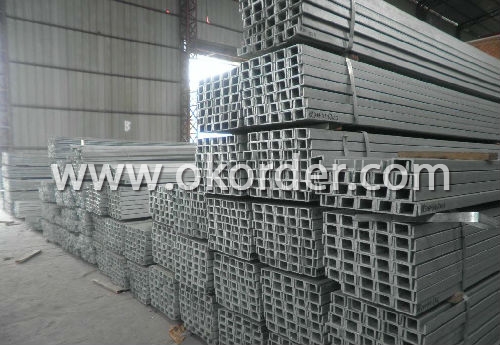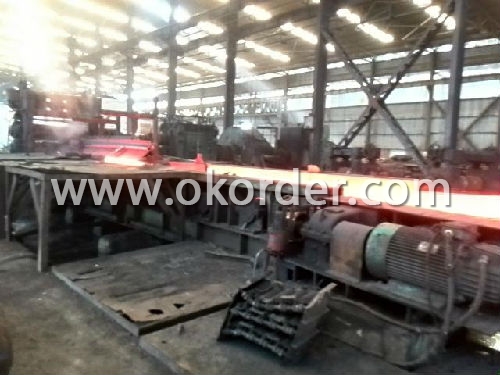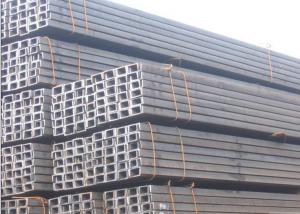Hot Rolled Channel steel
- Loading Port:
- Xingang Port
- Payment Terms:
- TT or LC
- Min Order Qty:
- 25MT m.t.
- Supply Capability:
- 80000-100000MTS/YEAR m.t./month
OKorder Service Pledge
OKorder Financial Service
You Might Also Like
Specifications of Hot Rolled Channel Steel:
1. We are definitely speciallizing in manufacturing and supplying channel steel as per japanese standard, which is characterised with high mechanical strength and competitive prices.
Original Place | Tangshan, China | Brand Name | UINDA |
Standard | JIS G3192 : 1990 | ||
Material Grade | SS540 | ||
Sizes | 50mm to 200mm | ||
Sales Volume/Year | 3000MT | ||
Destination Area | Middle East, Africa, Southeast Asia | ||
2. The sections in details are as followings in the table-1
JIS U CHANNEL | Standard | Sectional | Dimension |
| Mass: |
| (mm) | (mm) | (mm) | (mm) |
|
50x25 | 50 | 25 | 3.0 | 6.00 | 2.37 |
75X40 | 75 | 40 | 3.8 | 7.00 | 5.30 |
75X40 | 75 | 40 | 4.0 | 7.00 | 5.60 |
75X40 | 75 | 40 | 4.5 | 7.00 | 5.85 |
75X40 | 75 | 40 | 5.0 | 7.00 | 6.92 |
|
|
|
|
|
|
100X50 | 100 | 50 | 3.8 | 6.00 | 7.30 |
100X50 | 100 | 50 | 4.2 | 6.00 | 8.03 |
100X50 | 100 | 50 | 4.5 | 7.50 | 8.97 |
100X50 | 100 | 50 | 5.0 | 7.50 | 9.36 |
|
|
|
|
|
|
125X65 | 125 | 65 | 5.2 | 6.80 | 11.66 |
125X65 | 125 | 65 | 5.3 | 6.80 | 12.17 |
125X65 | 125 | 65 | 5.5 | 8.00 | 12.91 |
125X65 | 125 | 65 | 6.0 | 8.00 | 13.40 |
|
|
|
|
|
|
150x75 | 150 | 75 | 5.5 | 7.30 | 14.66 |
150x75 | 150 | 75 | 5.7 | 10.00 | 16.71 |
150x75 | 150 | 75 | 6.0 | 10.00 | 17.90 |
150x75 | 150 | 75 | 6.5 | 10.00 | 18.60 |
150x75 | 150 | 75 | 6.5 | 10.00 | 24.00 |
|
|
|
|
|
|
200X80 | 200 | 80 | 7.5 | 11.00 | 24.60 |
Table-1
3. The mechanical property of Hot Rolled Channel Steel in the table-2:
Grade | Yield Strength,N/mm² | Extension Strength N/mm² | |||
Thickness of Steel,mm | |||||
≦16 | >16-≦40 | >40-≦100 | >100 | ||
SS540 | ≧400 | ≧390 | - | - | ≧540 |
Table-2
4. The chemical composition of Hot Rolled Channel Steel as per SS540 in the table-3
Grade | Yield Strength,N/mm² | Extension Strength N/mm² | |||
Thickness of Steel,mm | |||||
≦16 | >16-≦40 | >40-≦100 | >100 | ||
SS540 | ≧400 | ≧390 | - | - | ≧540 |
Table-3
Usage of Hot Rolled Channel Steel:
1.The Hot Rolled Channel Steel can be devided into two kinds, namely common channel steel and light channel steel. The sizes of hot rolled common channel steel range from 5# to 40#. Meanwhile, the channel steel can be divided into cold forming sectional equal channel steel, cold forming sectional unequal channel steel, cold forming inner edge channel steel and outer edge channel steel.
2.The hot rolled channel steel is usually used for arch-itechtural structure, and they could be welded in order to support or hang a vari-ety of facilities. They are also usually used in combination with I beam. The channel steel with sizes under 14# is usually applied to construction engineering, as purline, while the channel steel with sizes above 16# is more likely to be used in building vehicle chassis structure and mechanical structure. Furthermore, the channel steel in sizes above 30# are target at building bridge structure, as tension bar.
3.In a word, the channel steel must possess perfect welding property, riveting property and mechanical property and so on.
Package & Delivery of Hot Rolled Channel Steel:
1.The hot rolled channel steel will be packed in bundle with steel wire at each end of every bundle and color marking in order to help the customer to recognize his goods more easily at sight.
2. And the channel steel could be loaded into 20ft or 40ft container, or by bulk cargo.If the weight of each bundle reaches more than 3.5 mt, the loading by break bulk cargo should be choosed.When the weight of each bundle reaches less than 3mt, the loading by container should be choosed.
3.As for the transportaion from mill to loading port, the truck will be usually used. And the maximum quantity for each truck is 40mt.
4.All in all, we could do in accordance with customer's request.

Production Flow of Hot Rolled Channel Steel:
1.The steel billet shall be heated in the high temperature furnace.
2. The heated steel billet shall be rolled five to nine times with the aim of shaping the general figure of steel u channel.
3. The rolled steel u channel should be put onto the cooling bed to make the temperature low.
4. The steel u channel should be straighted on the straightener.
5. The straighted steel u channel will be cut into meters by saw, as per customer's requirements.
6. At the last part of production, the channel steel must be tested in order to confirm that the finished products are completely free from crack, pore, slag, scab or fold on the surface.

- Q:18# channel perimeter
- You don't know where to use this data, in general, the characteristics of the data channel in section area and theoretical weight, I suggest you refer to GB/T 706-2008 "hot rolled steel", see annex, hoping to help you.
- Q:What are the different methods for protecting steel channels from impact damage?
- There are several methods for protecting steel channels from impact damage. One common approach is to apply protective coatings such as epoxy or polyurethane, which provide a barrier against impacts and abrasions. Another method is to install rubber or polyethylene buffers along the edges of the channels to absorb and distribute the impact force. Additionally, using impact-resistant guards or barriers can offer protection to the channels in high-risk areas. Reinforcing the channels with additional steel plates or structural elements can also enhance their resistance to impact damage.
- Q:What are the different shapes available in steel channels?
- There are various shapes available in steel channels, including C channels, U channels, J channels, and Hat channels.
- Q:Can steel channels be used for supporting mezzanine floors?
- Yes, steel channels can be used for supporting mezzanine floors. Steel channels are often used in construction for their strength and durability. They provide excellent support for mezzanine floors due to their ability to carry heavy loads and resist bending or twisting. Steel channels are commonly used in conjunction with other structural components, such as beams and columns, to create a sturdy framework for mezzanine floors. The use of steel channels ensures that the mezzanine floors can safely support additional weight, such as storage racks, equipment, or personnel, without compromising structural integrity.
- Q:Can steel channels be used in the construction of solar panel mounting structures?
- Yes, steel channels can be used in the construction of solar panel mounting structures. Steel channels provide strong support and stability, making them suitable for holding the weight of solar panels and withstanding various environmental conditions.
- Q:Do steel channels have any specific design considerations?
- Taking into account specific design considerations is necessary when dealing with steel channels. To begin with, the load-bearing capacity required for the specific application should be considered when designing steel channels. This involves calculating the maximum anticipated load that the channel will experience and selecting the appropriate size and thickness of the steel channel to adequately support that load. Furthermore, the desired span length and deflection criteria should be taken into account. Steel channels may deflect under load, so the design must ensure that the deflection remains within acceptable limits to avoid any structural issues or safety concerns. In addition, the design of steel channels should consider the type of connections that will be used to join the channels to other structural elements. This includes assessing the appropriate fasteners, welding techniques, or other connection methods to ensure a secure and long-lasting connection. Moreover, any specific environmental factors such as corrosion resistance requirements or exposure to extreme temperatures should be considered in the design. This may involve selecting a specific type of steel or applying protective coatings to enhance the durability and longevity of the channel. Overall, a safe and efficient design for steel channels should be based on a comprehensive understanding of the load requirements, structural considerations, and environmental factors to meet the intended application.
- Q:How do steel channels compare to I-beams?
- Steel channels and I-beams are frequently utilized in construction and engineering for their structural properties. Despite some similarities, they possess distinct characteristics. One notable disparity lies in their shapes. Steel channels exhibit a C-shaped cross-section, featuring two flanges on either side and a connecting web. This design grants excellent structural support and resistance to bending. Conversely, I-beams possess an I-shaped cross-section, incorporating two flanges and a central web. This configuration evenly distributes the load across the top and bottom flanges, enabling it to efficiently bear heavy loads and resist bending and deflection. Another distinction is their weight-bearing capacity. I-beams are renowned for their exceptional strength-to-weight ratio, making them suitable for carrying substantial loads over extended spans. Steel channels, though still sturdy, are typically employed for lighter applications or as secondary structural components. Cost can also influence the comparison between steel channels and I-beams. Generally, steel channels are more cost-effective due to their simpler manufacturing process and smaller size. However, the specific cost will depend on the materials' size, length, and quality. Regarding versatility, both steel channels and I-beams offer a broad range of applications. Steel channels are commonly used in construction for framing, support structures, and bracing. They can also serve as lintels or purlins. On the other hand, I-beams find extensive usage in the construction of bridges, buildings, and large-scale infrastructure projects that require the handling of heavy loads and long spans. In conclusion, steel channels and I-beams possess varying shapes, weight-bearing capacities, costs, and applications. Steel channels are typically more cost-effective and suitable for lighter applications, while I-beams offer superior strength, making them ideal for heavy loads and longer spans. The choice between the two depends on the project's specific requirements and the desired balance between strength, cost, and design.
- Q:How are steel channels used in construction?
- Steel channels are commonly used in construction to provide structural support in various applications such as framing, bracing, and reinforcing. They are typically used to create beams, columns, and trusses, which offer stability and strength to buildings and other structures. Additionally, steel channels are used as lintels to support openings in walls and as tracks for sliding doors or windows. Overall, steel channels play a crucial role in enhancing the structural integrity and durability of construction projects.
- Q:What are the different load distribution techniques for steel channels in floor systems?
- There are several different load distribution techniques for steel channels in floor systems. These techniques are used to effectively distribute the weight and load-bearing capacity of the floor system, ensuring its stability and structural integrity. One common load distribution technique is the use of evenly spaced steel channels throughout the floor system. These channels are typically installed perpendicular to the direction of the load, creating a grid-like pattern. This technique helps evenly distribute the weight across the entire floor system, preventing any individual channel from bearing an excessive amount of load. Another load distribution technique is the use of composite beams. In this technique, steel channels are combined with other materials, such as concrete or wood, to create a composite beam. The combination of materials helps distribute the load across a larger area, increasing the overall load-bearing capacity of the floor system. Additionally, load distribution can be achieved through the use of beam supports or joists. These supports are installed underneath the steel channels to provide additional strength and distribute the load to the surrounding areas. Beam supports can be made of steel, wood, or other materials depending on the specific requirements of the floor system. Finally, the load distribution technique can also be influenced by the design of the floor system itself. For example, the placement and spacing of the steel channels can be optimized to distribute the load more effectively. Additionally, the use of additional reinforcement, such as steel plates or braces, can further enhance the load distribution capabilities of the floor system. In summary, load distribution techniques for steel channels in floor systems include the use of evenly spaced channels, composite beams, beam supports, and optimized system design. These techniques help ensure that the weight and load-bearing capacity of the floor system is distributed effectively, resulting in a stable and structurally sound construction.
- Q:Can steel channels be used as support beams?
- Yes, steel channels can be used as support beams. Steel channels, also known as C-channels or U-channels, are commonly used in construction for their strength and structural stability. They are specifically designed to provide support and stability, making them suitable for use as support beams. Steel channels are often used in various applications such as building frames, bridges, and industrial structures, where their load-bearing capabilities are crucial. They offer high strength-to-weight ratio, durability, and resistance to bending and twisting forces, making them an ideal choice for supporting heavy loads and distributing weight effectively. Therefore, steel channels can be confidently used as support beams in various construction projects.
1. Manufacturer Overview |
|
|---|---|
| Location | Tangshan, China |
| Year Established | 2000 |
| Annual Output Value | Above US$ 50 Million |
| Main Markets | Mid East; Southeast Asia; Korea |
| Company Certifications | |
2. Manufacturer Certificates |
|
|---|---|
| a) Certification Name | |
| Range | |
| Reference | |
| Validity Period | |
3. Manufacturer Capability |
|
|---|---|
| a)Trade Capacity | |
| Nearest Port | Tianjin |
| Export Percentage | 20% - 30% |
| No.of Employees in Trade Department | 10-20 People |
| Language Spoken: | English; Chinese |
| b)Factory Information | |
| Factory Size: | Above 81,000 square meters |
| No. of Production Lines | 1 |
| Contract Manufacturing | OEM Service Offered |
| Product Price Range | Average |
Send your message to us
Hot Rolled Channel steel
- Loading Port:
- Xingang Port
- Payment Terms:
- TT or LC
- Min Order Qty:
- 25MT m.t.
- Supply Capability:
- 80000-100000MTS/YEAR m.t./month
OKorder Service Pledge
OKorder Financial Service
Similar products
New products
Hot products
Hot Searches
Related keywords




























